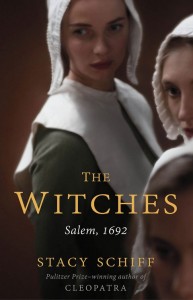The Witches: Salem, 1692, by Stacy Schiff
This review of Stacy Schiff's historical narrative, “The Witches: Salem, 1692," was published October 2015 in The Seattle Times.
 The founders of this country considered Americans special — particularly brave, uniquely moral, relentlessly just. How to reconcile that with hanging innocent people as witches, and doing it on the say-so of some rebellious teenage girls?
The founders of this country considered Americans special — particularly brave, uniquely moral, relentlessly just. How to reconcile that with hanging innocent people as witches, and doing it on the say-so of some rebellious teenage girls?
The answer to this riddle has consumed historians for more than 300 years. Undaunted, Stacy Schiff plunges in with an ambitious new work, “The Witches: Salem, 1692,” probing nine months of secrecy, rumor and death that have spawned as many theories as the Kennedy assassination.
Little wonder. Between January and September 1692, some 200 people were accused and nearly two dozen executed. One man was publicly tortured to death. Meanwhile, almost anyone who confessed was spared. Schiff calls it “our national crack-up.”
This Pulitzer Prize-winning writer, who vaulted to popular acclaim in 2010 with “Cleopatra: A Life,” has made a career of investigating unexpectedly powerful women, and she does so again in “The Witches.”
With a bravura introduction, Schiff sets the stage, painting Salem as a backwater populated by a few hundred humorless and self-righteous souls. No pastor wanted to serve there. Even nearby Bostonians thought the villagers odd. Perched at the edge of the wilderness, they lived in a near-constant state of fear — fear of Indian attack, of the weather, of darkness and disease.
For such a community, witchcraft served a useful purpose: “The aggravating, the confounding, the humiliating all dissolved in its caldron,” Schiff writes. “It made sense of the unfortunate and the eerie, the sick child and the rancid butter along with the killer cat. What else, shrugged one husband, could have caused the black and blue marks on his wife’s arm?”
Any number of unpalatable things, and Schiff is largely concerned with these. Daily life for Puritan women and girls was a monotony of joyless labor and Bible study interspersed with groping from stepfathers, masters and servant boys. Inconveniently, none of the girls’ words survive in diaries or letters, which may be why “we have turned a story about women in peril into one about perilous women,” Schiff observes with characteristically dry wit.
Many academics have already exhausted themselves on this terrain, proffering explanations from the sexual to the economic (some of the accused were embroiled in property disputes with accusers’ families), and more than a few are taking shots at Schiff for lacking credentials as a historian.
True, but she writes better. Schiff’s contribution is her ability to render history in vital detail, and from a contemporary perspective: “Things disturb us in the night. Sometimes they are our consciences. Sometimes they are our secrets. Sometimes they are our fears. Often what pinches, pricks, gnaws, claws, stabs and suffocates, like a seventeenth-century witch, is the irritatingly unsolved puzzle in the next room.”
In previous biographies, she has kept her focus on the narrative journey of a main character — be that Ben Franklin or Cleopatra — even while overlaying it with pages of historical detail. Schiff’s challenge in “The Witches” is to trace the story of a time, rather than a person, and to paint with no fewer than 89 characters (a helpful cast of characters is included).
There are a few clunky allusions to Harry Potter and “Survivor,” and some may accuse Schiff of making too many pop-psychology leaps (“wanton self-abuse comes naturally to a teenager”). But she raises provocative questions as to who was most guilty — youthful accusers like 9-year-old Betty Parris, or the judicial authorities who danced to their tune.
The Puritans were avid record-keepers, yet they left no in-the-moment journals from those nine horrible months. Even letters written from a father to son during the period avoid mention of what was happening in their town, as if no one could bear to say it out loud.
